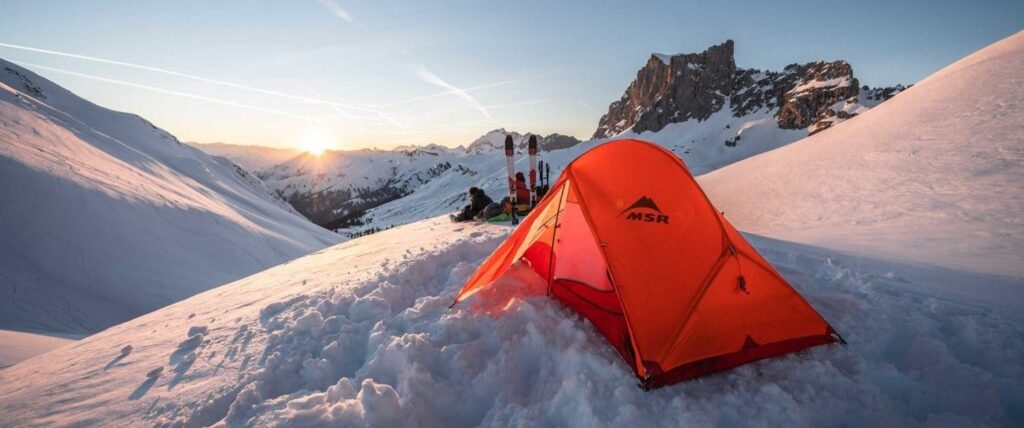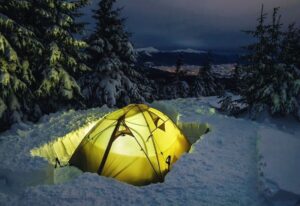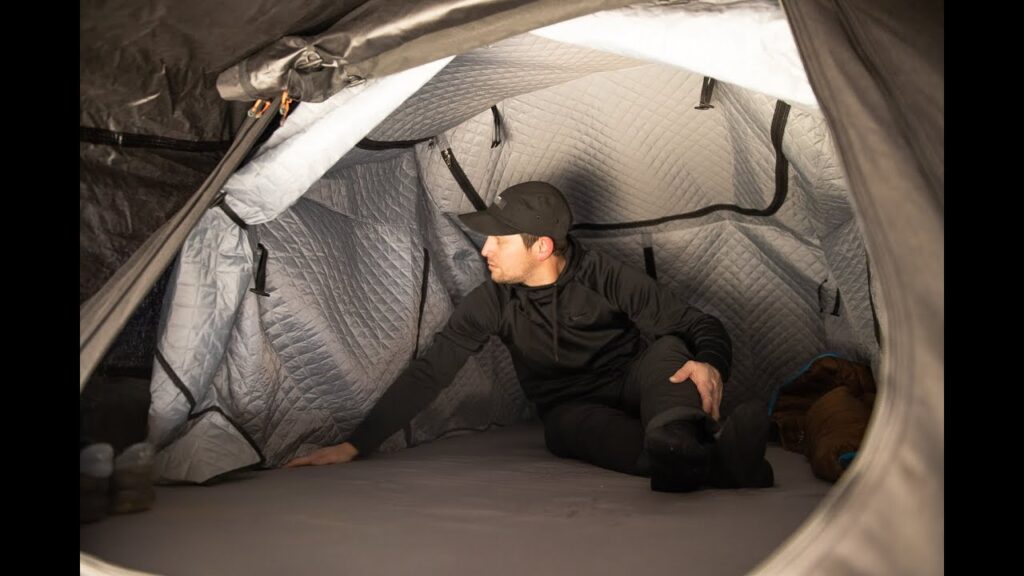How to Insulate a Tent for Winter Camping
Find yourself ill-prepared to camp during the winter? Learn exactly how to insulate a tent for winter camping so you can properly enjoy the experience. Camping in the winter isn’t for everyone but if done right it can lead to newfound hobbies like snowshoeing, cross-country skiing, and more.
Leaving the hot summer camping and heading into the snow, cold temperatures, high winds, and the harsh conditions of winter can be scary at first. Being properly prepared for winter conditions is key to truly enjoy a quiet winter wonderland.
1) Tent style
Choose a 4-season tent instead of 3 seasons tent. Having a 4 season tent will immediately give you an upper hand on the elements.
4 season tents are built to withstand tougher weather conditions like snow, wind, ice, and cold weather. Designed with aluminum frames, stronger rain flies, nylon or polyester fabric, and wind/condensation vents allows these tents to more efficiently withstand and protect from tough weather conditions.
A traditional 3-season tent is made with plastic poles and mesh walls allowing them to be simple and lightweight but not built to withstand anything more the light wind and rain. A 3-season tent is great for summer and spring camping but doesn’t quite cut it when it comes to winter camping. Mesh walls limit condensation and allow for consistent airflow throughout the tent.
Having a 4- season tent that is designed to withstand the winter saves time and energy since a lot of the work to insulate the tent is already done!

2) Tent Size
A small tent is key for staying warm in the winter. With less space in the tent, there is intern less air around to heat up. This helps the air inside the tent heat up and stay that way longer than in a larger-sized tent.
If possible pick a tent that is rated for the number of people that will be staying in it. This may make the tent slightly more packed since many people like extra room for them selfs and stuff. Even though it may be a little less comfortable having a small and tightly packed tent makes a significant impact on the temperature.
The smaller and more packed the tent is significant changes the temperature due to there being less space to heat up. Finding a happy medium for the tent size will help both comfort and warmth while winter camping.
3) Floor Insulation
Few people think about isolating the ground and tent floor while camping in the winter. Whether camping on solid ground or packed down snow cold air can easily get in through the floor of a tent.
Solid ground is usually frozen during the winter making it just as cold as the outside temperature. The soil will conduct the outdoor temperature and bring it in through the bottom of a tent if not properly insulated.
An insulated footprint is one of the best ways to make sure you aren’t laying directly on the cold ground. Thermal blankets along with a tarp are also a great way to keep the cold air out. A thermal blanket or insulated footprint will help reflect the cold air coming from the ground. As well as help trap the warmer air from inside of the tent.
If camping on top of snow it is best if you are able to find the bare ground. Digging an area out of the snow for the tent to fit or finding a bare spot with little snow is the best way around it. If there is too much snow for either of these options bringing an extra layer to put the tent on will make a big difference. Extra tarps, fallen leaves/ shrubbery, or sleeping pads can all be a great way to get the tent off of direct contact with the snow.

4) Stay Away From Air Mattresses
Many people like the luxury of camping with an air mattress but they can actually do more harm than good in the winter.
As stated before limiting the amount of air in the tent helps reduce the effort it takes to keep the inside of a tent warm. An air mattress does the complete opposite. The surface temperature of an air mattress is very similar to the temperature of the air around, making it very inefficient to keep a tent warm.
An air mattress will stay about the same temperature all night compared to a foam mat where it will quickly heat up with body heat making it warmer to sleep on.
5) Keep Covered
If you have a good 4-season tent it will come with a high-quality rain fly that is built to protect from strong winds and reflect cold air out and trap the warm air in. But a generic rain fly from a 3 season tent won’t do the job meaning you have to do the extra work to keep covered.
Similar to insulating the floor thermal blankets and tarps work best. The thermal blankets keep the warm air from escaping and reflecting the cold air while the tarp protects from heavy winds and other conditions.
The key is to make sure the entire tent is covered. With most traditional rain flies there is a large gap around the rain fly from the ground up. Closing up the gaps so the taps are flush with the ground helps block out the wind and reduce cold air getting in and warm air getting out.
6) Insulate The Walls
Similar to insulating a house, find a material that is thick and has a lot of air pockets to catch and trap cold air coming in. Material like foam, wool, or other thick blankets or clothing can do the job.
Once finding the material it is time to line the walls with it. Putting the insulation on the outside makes for easier installment and gives more space inside the tent. Before putting the rain fly on lay whatever insulation material you have over the tent to completely cover the walls. Tape or other techniques of securing the insulation to the tent walls may be necessary.

7) Proper Sleeping Gear
Having the right gear makes a world of difference when it comes to camping in the winter. Some of the most important gear needed is a cold weather-rated sleeping bag, good clothes, and warmers.
Having a properly rated sleeping bag is the best way to stay comfortable in the cold weather of winter camping. Sleeping bags can be rated for below zero weather meaning there is a good fit for whatever weather you plan on facing.
Having the right clothes on while sleeping can also make a huge difference. Some types of clothing can actually make you colder no matter how many layers you may have on. A synthetic dissipating sweat material like polyester or nylon works great as a base layer. Many don’t think that sweat is much of a problem in the winter but any sweat or precipitation on the body will rapidly cool you down. After the base layer, a warm wool layer is exactly what will warm the body up.
Hand warmers and a hot rock can be some of the best ways to heat up a tent and sleeping bag in the winter. Putting something warm that gives off heat inside a sleeping bag before bed will feel heavenly before bed. Or find out if a propane heater can work for you!
Conclusion
Having the proper gear is key to all camping but especially when it comes down to winter camping. Insulating a tent for winter camping is needed but not as necessary when owning the proper equipment.
Layers for both yourself and the tent are very important. Having multiple lays of different materials that both reflect cold and warm things up will help everything. Materials like wool, polyester, nylon, and thermal blankets are all a must when out camping in the winter.
Being prepared and having a plan before braving the harsh winters will help with a better experience and keep you safe! Learn more tips about how to stay warm while camping.
